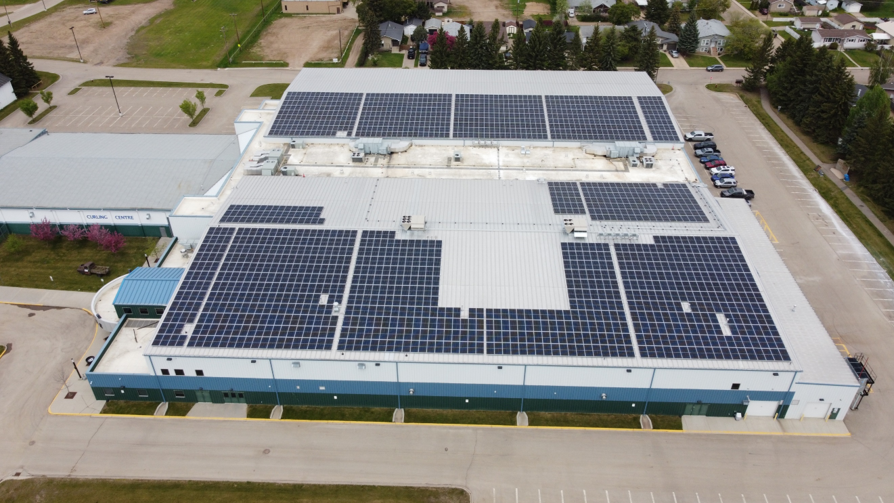4-minute read
Municipalities across Alberta are taking advantage of the abundant sunshine by installing solar photovoltaics (PV) to lower utility costs, reduce greenhouse gas (GHG) emissions, and generate their own electricity.
Onsite solar photovoltaic (PV) projects are made possible in Alberta through the Micro-generation Regulation, which governs how residents, businesses, and municipalities generate their own renewable energy. This regulation also makes it possible to receive credits for any excess electricity fed to the grid from onsite generators.
Municipalities are especially well-positioned to become micro-generators of solar energy. Alberta municipalities are ideal solar generators – here’s why!
1. Municipalities use a lot of energy
Municipalities deliver dozens of key services to their communities, covering everything from recreation programs to water treatment. The infrastructure required to support these services uses a significant amount of energy. Renewable energy systems can generate enough electricity to offset all, or a portion, of the total annual electricity consumption at a single site or multiple aggregated sites.
Note: The Micro-generation Regulation allows for systems up to 5 MW in size, as long as they do not generate more electricity than is used by the site or aggregated sites over the course of a year.
The regulation allows municipalities to offset significant amounts of their electricity consumption by generating their own solar energy. This can save a municipality thousands of dollars on their utility bills (which can then be invested back into key services). It also builds a cleaner community by reducing GHG emissions. The Micro-generation Regulation is flexible, so municipalities can choose to offset as much electricity as makes sense for their situation.
Funding is available
Municipalities are eligible for funding through the Alberta Municipal Solar Program (AMSP). This funding lowers the upfront capital costs of onsite solar PV installations, allowing municipalities to realize energy savings even sooner.
Past participants have accessed this program to install micro-generation systems of a few kilowatts, to offset a portion of a single facility’s electricity use, to a collection of systems which work together to achieve net-zero in electricity consumption in municipal operations.
Here’s what Raymond’s Chief Administrative Officer had to say about becoming the first net-zero community in Alberta with funding from the AMSP:
“This decision by council to become one of the first municipalities in Alberta to become electrically net-zero was made with the future in mind. It provides us budgetary certainty regardless of the geopolitical and market factors outside of our control and allows us to stretch our limited resources further than we could before.”
– Kurtis Pratt, Chief Administrative Officer, Town of Raymond

2. Municipalities have a lot of roof space
Alberta’s electricity has traditionally been produced by large high-emitting generators that are located far from the municipalities that consume the energy. By installing solar PV directly on municipal buildings, energy is produced locally. This creates local jobs, increases generation efficiency, and minimizes transmission line losses.
As reported by the Alberta Electric System Operator (AESO), as of May 2020 there are 5,579 micro-generation sites in Alberta, the majority of which are rooftop solar PV. Rooftops are ideal locations for solar PV as they are often large, uniform, unused surfaces with unimpeded access to sunlight. Municipalities usually own several facilities with roof space perfectly suited for solar PV, which allows them to generate their own electricity while maintaining precious greenfield space for other uses in the community.
Through the AMSP, participants have installed solar on rooftops of administration buildings, recreation centres, and even fire halls.
Table 1. Micro-generation and Small Distributed Generation by Energy Source in Alberta as of May 2020. AESO Microgen DG Report June 2020.

Choosing a rooftop
When choosing a rooftop location for a solar PV project, there are several important factors to consider:
- age,
- material of the roof,
- pitch,
- potential shading, and
- tilt and orientation of the installed modules.
In all cases a structural engineer should assess the roof and building to determine its ability to support the additional load of the solar PV system.

3. Municipalities are well-positioned to aggregate sites
Rooftop solar PV systems are the logical choice for many micro-generators such as residents and businesses. Municipalities, however, often have the advantage of access to both roof space and large parcels of unused or pre-disturbed land, such as brownfields. These large parcels of land are excellent candidates for large, centralized ground-mount solar PV arrays. The Micro-generation Regulation also allows systems to be sized to offset electricity use at multiple aggregated sites versus the sole site the generator is connected to.
In terms of the regulation, ‘aggregated sites’ means two or more sites that are:
- located on property that is owned or leased by the same customer,
- connected to a single feeder line owned by one wire service provider, and
- enrolled with the same retailer and charged at the same rate.
This ability to aggregate loads is a big benefit to municipalities. As large energy consumers, they are owners of multiple sites which are usually on the same local feeder line and a customer of the same retailer.
Municipalities are taking full advantage of aggregation by installing large, centralized, ground-mount solar PV arrays at sites like lift stations or other unused parcels of municipal land. They are sizing them to offset the load of the installation site as well as other municipally-owned sites, such as streetlights, community centres, or protective services buildings. These large centralized arrays directly offset actual electricity used at the site where it is connected and a monetary credit is included on the electricity bill for all excess electricity generated to cover the aggregated load.

Viking, like a handful of other municipalities receiving funding through the Alberta Municipal Solar Program, has aggregated multiple municipal loads and is offsetting them with one large solar PV array.
Watch: The Town of Viking recently energized their 1.05 MW ground-mount solar pv array, designed to produce enough electricity to offset 100% of Town operations’ annual electricity use. In this webinar, you’ll learn more about the project, how they did it, lessons learned, benefits, and how you can do it too.
One of the major benefits of the aggregation approach is that projects can more easily achieve economies of scale with a single large project rather than several dispersed projects. This typically means a lower price for an equivalent number of kilowatts installed across the community, allowing municipalities to see positive cashflow even sooner.
Additionally, since aggregating sites allows for an increased single system size, if the project is 150 kW or larger it will classify as a “large micro-generator” through the Micro-generation Regulation. In this case, all electricity sent back to the grid is credited at the hourly wholesale electricity market price. This can be financially beneficial as peak solar generation often occurs during higher pool price times, such as during the summer, meaning a better price for the exported electricity.
In short, more money for the municipality.
Whether small or large systems, rooftop or ground-mount, municipalities are ideally positioned to take advantage of the Micro-generation Regulation in Alberta.
Ready to take action?
Submit an Expression of Interest to the Alberta Municipal Solar Program.
Not sure how to start? Check out these resources:


You must be logged in to post a comment.